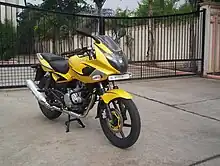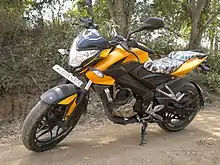 | |
| Type | Public |
|---|---|
| ISIN | INE917I01010 |
| Industry | Automotive |
| Founded | 29 November 1945 |
| Founder | Jamnalal Bajaj Rogen Frias |
| Headquarters | Pune, Maharashtra, India |
Areas served | Worldwide |
Key people | Rajiv Bajaj (Chairman, MD & CEO) |
| Products | Motorcycles and three-wheeler vehicles |
Production output | |
| Revenue | |
| Total assets | |
| Total equity | |
Number of employees | 10,000 (2019)[1] |
| Parent | Bajaj Group |
| Website | bajajauto.com globalbajaj.com |
Bajaj Auto Limited (/ˌbəˈdʒɑːdʒ/) is an Indian multinational automotive manufacturing company based in Pune.[2] It manufactures motorcycles, scooters and auto rickshaws. Bajaj Auto is a part of the Bajaj Group. It was founded by Jamnalal Bajaj (1889–1942) in Rajasthan in the 1940s.
Bajaj Auto is the world's third-largest manufacturer of motorcycles and the second-largest in India.[3] It is the world's largest three-wheeler manufacturer.[4] In December 2020, Bajaj Auto crossed a market capitalisation of ₹1 trillion (US$13 billion), making it the world's most valuable two-wheeler company.[5]
History

Bajaj Auto was established on 29 November 1945 as M/s Bachraj Trading Corporation Private Limited.[6] It initially imported and sold two- and three-wheelers in India.[6] In 1959, it obtained a license from the Government of India to manufacture two-wheelers and three-wheelers and obtained a licence from Piaggio to manufacture Vespa scooters in India.[6] It became a public limited company in 1960.[6]
With the launch of motorcycles in 1986, the company changed its branding from a scooter manufacturer to a two-wheeler manufacturer.[7]
In 1984, Bajaj Auto signed a technical assistance agreement with Kawasaki, cooperating to expand production and sales of motorcycles in the local market.[8]
In the early 2000s, Bajaj Auto bought a controlling stake in the Tempo Firodia company, renaming it "Bajaj Tempo". Germany's Daimler-Benz owned 16% of Bajaj Tempo, but Daimler sold their stake back to the Firodia group. It was agreed that Bajaj Tempo would gradually phase out the use of the "Tempo" brand name, as it still belonged to Mercedes-Benz.[9][10] The name of the company was changed to Force Motors in 2005, dropping "Bajaj" as well as "Tempo", over the objections of Bajaj Auto with whom the company shares a long history as well as a compound wall.[11]
In 2007, Bajaj Auto, through its Dutch subsidiary Bajaj Auto International Holding BV, purchased a 14.5% stake of Austrian rival KTM,[12] gradually increasing its stake to a 48% non-controlling share by 2020. In December 2020, Bajaj started discussions on swapping its stake from KTM to KTM's controlling shareholder Pierer Mobility, a subsidiary of Pierer Industrie.[13]
On 26 May 2008, Bajaj Auto Limited was split off into three corporate entities — Bajaj Finserv Limited (BFL), Bajaj Auto Ltd (BAL), and Bajaj Holdings and Investment Ltd (BHIL).[14][15]
In 2017, Bajaj Auto and Triumph Motorcycles Ltd teamed up to build mid-capacity motorcycles.[16]
In 2017, Bajaj and Kawasaki ended a sales and services partnership in India for the sale and after-sales service of Kawasaki motorcycles, which had been established in 2009. The partnership's dealerships were later converted into KTM ones. Bajaj and Kawasaki continue with their relationship in overseas markets.[17]
On 26 November 2019, Bajaj Auto invested about ₹57 crore ($8 million) in bicycle and electric scooter rental startup Yulu.[18] In this deal, Bajaj would also manufacture customised electric scooters for Yulu.[18]
Manufacturing
The company has plants in Chakan, Waluj in Aurangabad and Pantnagar.[19] The oldest plant at Akurdi in Pune houses the R&D centre 'Ahead'.[20]
Products


%252C_Jakarta.jpg.webp)
Bajaj manufactures and sells motorcycles, scooters, auto-rickshaws and cars.[21] As of 2004, Bajaj Auto was India's largest exporter of motorcycles.[22]
Bajaj is the first Indian two-wheeler manufacturer to deliver 4-stroke commuter motorcycles with sporty performance for the Indian market.[23] Bajaj achieved this with the 150cc and 180cc Pulsar.
Motorcycles produced by Bajaj include the CT 100 Platina,[24] Discover, Pulsar, Avenger, and Dominar. In FY 2012–13, it sold approximately 37.6 lakh (3.76 million) motorcycles which accounted for 31% of the market share in India. Of these, approximately 24.6 lakh (2.46 million) motorcycles (66%) were sold in India, and the remaining 34% were exported.
Auto rickshaw (three wheeler)
Bajaj is the world's largest manufacturer of auto rickshaws and accounts for almost 84% of India's three-wheeler exports. During the FY 2012–13, it sold approx. 4,80,000 three-wheelers which was 57% of the total market share in India. Out of these 4,80,000 three-wheelers, 47% were sold in the country and 53% were exported. In Indonesia, Bajaj three-wheelers are described as "iconic" and "ubiquitous" to the point that the word bajaj (pronounced bajay[25]) is used to refer to auto rickshaws of any kind.[26]
Low-cost cars
In 2010, Bajaj Auto announced cooperation with Renault and Nissan Motor to develop a US$2,500 car, aiming at a fuel efficiency of 30 kilometres per litre (85 mpg‑imp; 71 mpg‑US) (3.3 L/100 km), or twice an average small car, and carbon dioxide emissions of 100 g/km.[27][28]
On 3 January 2012, Bajaj auto unveiled the Bajaj Qute (formerly Bajaj RE60), a mini car for intra-city urban transportation, which is legally classified as a quadricycle. The target customer group was Bajaj's three-wheeler customers.[29] According to its Managing Director Rajiv Bajaj, the RE60 powered by a new 200 cc rear mounted petrol engine will have a top speed of 70 kilometres per hour (43 mph), a mileage of 35 kilometres per litre (99 mpg‑imp; 82 mpg‑US) and carbon dioxide emissions of 60 g/km.[29][30]
Electric scooters
Bajaj launched its first electric scooter, the Chetak, in India in January 2020.[31] In December 2021, Bajaj announced an investment of ₹300 crore to build an electric vehicle production facility in Pune. According to the company, the plant would be able to produce 500,000 electric vehicles (EVs) each year, catering to both domestic and international markets.[32]
Listing and shareholding
Listing
Bajaj Auto's equity shares are listed on Bombay Stock Exchange where it is a constituent of the BSE SENSEX index,[33] and the National Stock Exchange of India where it is a constituent of the CNX Nifty.[34]
Shareholding
On 31 December 2022, 54.98% of the equity shares of the company were owned by the promoters Bajaj Group and the remaining were owned by others.[35]
| Shareholders (as of 31 December 2022) | Shareholding % |
|---|---|
| Promoters: Bajaj Group | 54.98% |
| Mutual funds, FIs, and insurance companies | 09.73% |
| Foreign institutional investors | 11.82% |
| Individual shareholders | 09.55% |
| Bodies corporate | 04.35% |
| Foreign portfolio investments corporations | 00.60% |
| GDRs | NIL |
| Others | 08.97% |
| Total | 100.0% |
As of 31 March 2020, there were 100 funds that had disclosed positions in the company, including funds by The Vanguard Group, Dimensional Fund Advisors and Fidelity Investments.[36]
Employees
Bajaj Auto had a total of 10,000 employees as of 2019, of which 51 were women (0.63%) and 25 were differently-abled (0.31%).[37] It spent ₹650 crore (equivalent to ₹12 billion or US$150 million in 2023) on employee benefit expenses during the FY 2012–13. The company was headed by Rahul Bajaj until 2005 whose net worth was around US$2 billion in March 2013. Currently, his son Rajiv Bajaj heads company.[38]
See also
References
- 1 2 3 4 5 6 7 "Bajaj Auto Ltd Annual Report 2022". Bajaj Auto Ltd. Retrieved 20 October 2020.
- ↑ "Company Profile - Bajaj Auto". Equitylion. 11 June 2017. Retrieved 20 June 2017.
- ↑ "News Article". Reuters. 17 May 2012. Retrieved 22 May 2012.
- ↑ "India is the largest three-wheeler industry globally". Deccan Chronicle. 15 March 2016. Retrieved 15 December 2016.
The top-three players such as market leader Bajaj Auto, second largest manufacturer Piaggio and Mahindra and Mahindra […].
- ↑ "Bajaj Auto now world's most valuable two-wheeler brand: Crosses Rs 1 lakh crore market cap mark". Financial Express. 4 January 2021. Retrieved 4 January 2021.
- 1 2 3 4 "Bajaj Auto Ltd". Business Standard India. Retrieved 8 May 2020.
- ↑ "Bajaj Auto - A historical analysis- Business News". www.businesstoday.in. 30 October 2015. Retrieved 8 May 2020.
- ↑ Iyer, Satyanarayan (25 March 2017). "Bajaj Auto ends its partnership with Kawasaki in India". The Times of India.
- ↑ "Bajaj Tempo will now be Force Motors". The Times of India. 24 February 2005. Archived from the original on 21 September 2013. Retrieved 20 September 2013.
- ↑ M, Sabarinath; Kalesh, Baiju (18 August 2014). "Bajaj group sells three-fourths of its shares in Force Motors". The Economic Times. Retrieved 8 May 2020.
- ↑ "Bajaj Tempo will now be Force Motors". The Times of India. TNN. 24 February 2005. Retrieved 18 June 2018.
- ↑ Chowdhury, Anirban (31 March 2011). "Bajaj on Track for Low Cost Car Launch". Wall Street Journal. Retrieved 15 January 2021.
- ↑ Panday, Amit (1 December 2020). "Bajaj Auto eyes access to EV tech through KTM share swap". LiveMint. Retrieved 15 January 2021.
- ↑ "Bajaj Auto demerger complete". The Economic Times. 25 May 2008. Retrieved 21 May 2009.
- ↑ "Demerger News". Bajaj Auto. Archived from the original on 22 October 2013. Retrieved 27 October 2013.
- ↑ Gupta, Surajeet Das (17 August 2017). "Bikes from Bajaj tie-up will be sold here & exported too: Nick Bloor". Business Standard India.
- ↑ Narasimhan, T. E. (26 March 2017). "Bajaj, Kawasaki end sales tie-up". Business Standard India.
- 1 2 Shrivastava, Aditi (26 November 2019). "Bajaj Auto pumps in $8 million into mobility startup Yulu". The Economic Times. Retrieved 19 January 2021.
- ↑ "Bajaj Auto at Forbes". Forbes. 31 May 2013. Retrieved 27 October 2013.
- ↑ "Bajaj Auto may set up first electric vehicle plant in Akurdi". Moneycontrol. 8 November 2021. Retrieved 31 August 2022.
- ↑ Vira, Dhanil (22 July 2012). "The History Of Bajaj Auto". Motor Beam. Retrieved 8 May 2020.
- ↑ "Bajaj sales increase by 25 per cent in January - BikeWale".
- ↑ "Bajaj Dominar: Pursuit of perfection". kathmandupost.com. Retrieved 8 May 2020.
- ↑ "Bajaj Auto launches new Platina 100ES at INR 53,920 - ET Auto". ETAuto.com.
- ↑ Stevens, A.M. (2004). A comprehensive Indonesian-English Dictionary. Mizan. p. 78. ISBN 978-979-433-387-7.
- ↑ Aiyar, Pallavi (23 June 2013). "The ubiquitous Bajaj remains an Indonesian Icon". The Hindu.
- ↑ "How green is my low-cost car? India revs up debate". ENN. 19 June 2008. Retrieved 24 November 2010.
- ↑ "Bajaj small car may cost Rs 1.1 lakh – News – Zigwheels". Timesofindia.zigwheels.com. Archived from the original on 30 May 2010. Retrieved 24 November 2010.
- 1 2 "Bajaj Auto unveils small car RE 60 in partnership with Nissan and Renault". The Times of India. 3 January 2012. Retrieved 3 January 2012.
- ↑ Saxen, Ruchita (3 January 2012). "Bajaj Auto launches low cost car RE 60, promises 40 km per litre". New Delhi Television. Retrieved 3 January 2012.
- ↑ "Bajaj Chetak electric scooter launched, price starts at Rs 1 lakh". Hindustan Times. 14 January 2020.
- ↑ "Bajaj Auto to set up Rs 300-crore EV plant". 30 December 2021.
- ↑ "Scripwise Weightages in S&P BSE SENSEX". BSE India. Archived from the original on 1 December 2015. Retrieved 27 October 2013.
- ↑ "Download List of CNX Nifty stocks (.csv)". NSE India. Retrieved 27 October 2013.
- ↑ "Latest BAJAJ AUTO Shareholding Pattern". Equitymaster. Retrieved 25 January 2023.
- ↑ "BAJAJ-AUTO / BAJAJ AUTO LTD. - Institutional Ownership and Shareholders". Fintel.
- ↑ "Business Responsibility Report 2012-13" (PDF). Bajaj Auto. Archived from the original (PDF) on 29 October 2013. Retrieved 27 October 2013.
- ↑ "Rahul Bajaj at Forbes". Forbes. Retrieved 27 October 2013.
External links
- Official website
- Business data for Bajaj Auto: